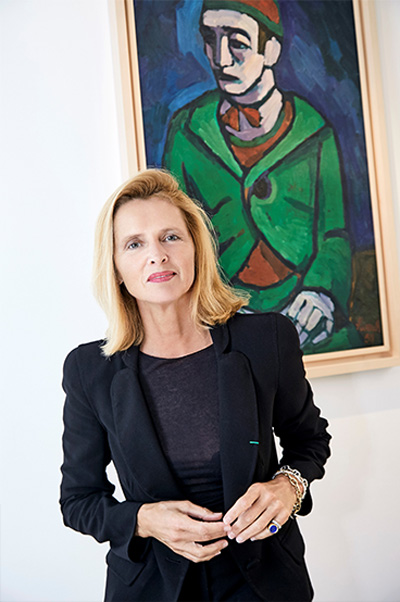 6 min
6 min
Jana Revedin is an architect, doctor of architectural and urban sciences and full professor at the École Spéciale d’Architecture in Paris. In 2006, she created the Global Award for Sustainable Architecture™, which each year rewards architects committed to the search for a new architectural ethics. Jana agreed to share her humanist vision of architecture with us.
Should architecture undergo a revolution? And if so, how?
Architects have been revolutionary minds ever since the very beginning. Our professional and humanistic ethics ask of us not to repeat comfortable solutions, but to tirelessly explore the most adaptive way to assure life on this planet. Firmitas, utilitas, venustas demanded Vitruvius, the first architectural theoretician from the 1st century BC – stability, thus sustainability, usefulness, and beauty. The Bauhaus a hundred years ago called for urban and architectural ecology, living environments for the benefit of users – and all users, not just a social elite. Why did we forget these meaningful mottos? Because since the 1940s the Concrete building industry, following the dogmas of Le Corbusier’s tabula rasa, installed architectural colonialism around the globe. It eliminated local know-how, vernacular rootedness, user participation, and the human dimension of the built environment.
But the counter-revolution is in full swing, the paradigm change towards a human-minded architecture, respectful of geo and bio-sourced energies, structures and materials of all continents is advancing. Let us, on top of the Sustainable Goals set by the UN, fight for beauty, character, ambiance, quality of daily life and health, all measurable by our 5 senses. Because technical advantages alone only touch the minds, but not the hearts of our clients.
What are the 3 challenges facing the construction sector to accelerate the adoption of more sustainable practices?
First, territorializing, the rooting in a specific context, its culture, its traditions, its social and political truth, but also in its evident resources. The search for sustainable design and construction solutions needs to be installed in every context, on any scale, and including every detail. We need energy to produce glass – one of the most sustainable materials mankind invented – in a certain climatic and geological context? Let us find ways to feed our production lines by solar, geothermic, wind, air or liquified natural gas energy. We need foils to protect our isolation materials inside light-frame building processes? Let us search for locally sourcable bio-polymer solutions instead of traditional PVCs.
Second, rehabilitation of the “already there”1 . We need to intelligently profit from all grey energy already invested in the built environments of this planet, and we need to do it in a joyful and creative way. Transformation is the key word here, and architects and designers must give up the arrogant idea of building monuments to themselves. Third, my favorite research and teaching line, experimentation. Experimentation in light and recyclable structures, geo- and bio-sourced materials, inventive transport, logistic and assembly solutions, but most of all experimentation in our architectural and urban design processes, which have to include the users and their life cycles.
Adaptability is our most urgent task; our projects need to transform themselves following the changing needs of society. “Experimentation, the action or process of trying out new ideas, methods, or activities, can be first of all understood as research on future building structures and materials, but secondly as an applied trial-and-error exploration of design processes that meet our user’s needs. Experimental participatory design “with and by the people” has finally gained momentum in the design practices of the younger generation of architects and encourages more collaborative, experiential and iterative forms of “active pedagogy”.”2
What do you thus consider to be the 3 most emblematic recent achievement in terms of sustainable construction?
First, the re-discovery of the circular economy, forgotten over 100 years of a boundless world conquest of inflexible and un-reusable building structures: Take for example today’s research and experimentation of recycling concrete, glass and ceramics, of bio-polymers, 3D earth-printing or fiber-light-structures. Second, the re-discovery of the living, the connections between all inhabitants of this planet, the re-discovery of the fruitful dimension of participation in “vita activa” building processes – keep an eye on their emancipatory catalyst effects!
Finally, the re-discovery of Vitruvius’ venustas, the missing link, the turning point. If we invest in a sustainable building, which cognitive and sensorial advantages will it provide? How is our quality of life inside it, our children’s, our elderly’s, our colleagues’, the disadvantaged’s, the marginalized members of society? What memories does it bring back, which perspectives does it offer? Sustainable construction is most of all about feelings. The most important of which is the feeling of meaningfully belonging to this earth.
- Jana Revedin, L’Architecte et l’existant : construire avec ce qui est déjà là, with a foreword by Charles Landry, Gallimard, Collection Manifesto, Paris 2022
- Jana Revedin, Architecture Is Experimentation, ArchiTangle, Berlin 2024
To go further:• Revedin Jana, Architecture Is Experimentation, ArchiTangle, Berlin 2024
• Revedin Jana, Architecture Is Education, ArchiTangle, Berlin 2024
• Revedin Jana, Radicant Design : How to co-create sustainable living space, Eliva Press, New York 2021
• Revedin Jana, “L’Architecte et l’existant: Construire avec ce qui est déjà là”, with a foreword by Charles Landry, Gallimard, collection Manifesto, Paris 2022
• Revedin Jana, Construire avec l ́immatériel: Temps, usages, communauté, droit, climat ... Nouvelles ressources pour l ́architecture, with a foreword by Pascal Nicolas Le Strat, Paris, Gallimard, Collection Manifesto, 2018.
• Revedin Jana, La ville rebelle: Démocratiser le projet urbain, with a foreword by Yona Friedman and an epilogue by Christopher Alexander, Paris, Gallimard Collection Manifesto, 2015.
Upcoming Architects' Perspectives:Rosanna Forray: “Architects in Chile have been engaged in a slow revolution for over twenty years.”
Photo credits: Klaus K. Loenhart, Global Award for Sustainable Architecture laureate 2024, BREATHE ©Terrain Marc Lins Jana Revedin, © Martin Rauchenwald







